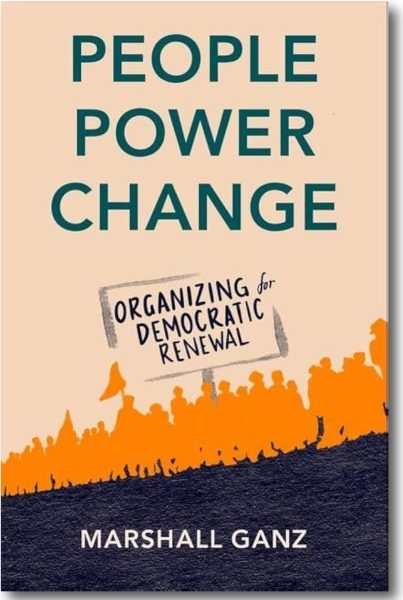 Public interest communications is the work of transformation. Creating a safe, just, and equitable world requires us to transform apathy into caring, caring into action, and action into deep lasting change. Marshall Ganz’s new book, People Power Change: Organizing for Democratic Renewal, provides a framework to build your craft of connecting hearts (caring), heads (strategy) and hands (action). The lessons within are both practical and inspiring: a winning combination.
Public interest communications is the work of transformation. Creating a safe, just, and equitable world requires us to transform apathy into caring, caring into action, and action into deep lasting change. Marshall Ganz’s new book, People Power Change: Organizing for Democratic Renewal, provides a framework to build your craft of connecting hearts (caring), heads (strategy) and hands (action). The lessons within are both practical and inspiring: a winning combination.
I’ve been fortunate to take classes with Ganz, and reading this book was like sitting in those classes. So, if you don’t have the time for an intensive 3-month virtual class at Harvard, this book is for you.
Here are my top takeaways, which will hopefully convince you to make this your winter read:
Create connection by listening to and telling stories.
Whether you are building and strengthening community grassroots-style, or you’ve earned your way into a billionaire philanthropist’s office, stories remain the number one tool you have for creating meaningful connections and relationships. Being able to articulate your story and the story of your organization is important, but equally valuable is having the tools to listen and draw out the story of the person you are meeting. What are the values that intrigue them about this work? What are the experiences that have made them care?
Ganz’s teaching on public narrative is invaluable for making a connection at the heart level with your partners and donors that will last past this giving season.

Image generated with the help of AI.
In times of change and loss, build an empathetic bridge.
Our organizations, communities, and countries go through periods of uncertainty and even devastation. How can we shepherd our teams and constituents through times of loss and upheaval?
Whether it is a loss at a leadership level, big changes in organizational structure, funding, or laws that affect our work, Ganz’s concept of the “empathetic bridge” reminds us that first and foremost we must acknowledge the change and the emotions that go along with that. Rather than rushing to action, we should harness the emotional resources that arise through processing frustration, anger, and sadness.
I think of this like gasoline (if you’ll forgive the fossil fuel metaphor). Frustration, anger, sadness, rage – these are fuel to create change, but not if we spray them out into the air. We need to aim the gasoline into our engines to get where we are going.
Don’t fall flat on your ask.
If you’ve attended a Goodman Center Strategic Communications webinar, you’ve heard us say this before. If you have managed to turn that apathy into care and have a potential donor, partner, or volunteer pumped up and ready to get to work, you must have an action for them to take that they can commit to. You also must be able to convince them that this action will make a difference.
In his chapter about action, Ganz digs into the process of securing commitments from our partners. “The key is not making it an easy ask but rather in making a valuable ask.” What difference will it make if I sign up for your newsletter? How do I know that my $5, $50, or $5,000,000 is going to have a real impact if I give that to you? This is about offering proof with story and data and seeing a request to commit not as a burden but as an investment in a better future. Our audiences want a chance to make the world a better place. You are offering them that very thing. Do they know how it works?
The wisdom in People Power Change is speaking directly to organizers and social justice movements, and I believe that the same craft used for building those communities can be harnessed into a force for good by anyone working to transform our world.